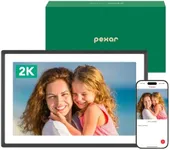Buying Guide for the Best Digital Picture Frame
Choosing the right digital picture frame can enhance your experience of displaying and sharing your favorite photos. When selecting a digital picture frame, consider the key specifications that will impact the quality, functionality, and ease of use. Understanding these specs will help you make an informed decision that best fits your needs and preferences.Screen SizeScreen size refers to the diagonal measurement of the display area. It is important because it determines how large your photos will appear. Smaller screens (7-8 inches) are more compact and suitable for desks or small spaces, while larger screens (10 inches and above) are better for living rooms or areas where you want your photos to be more prominent. Choose a screen size based on where you plan to place the frame and how visible you want the photos to be.
ResolutionResolution indicates the number of pixels on the screen, affecting the clarity and detail of the images. Higher resolution (e.g., 1920x1080 or higher) means sharper and more detailed photos, which is especially important for larger screens. Lower resolution (e.g., 800x600) may be sufficient for smaller screens but can result in less crisp images. If you want your photos to look their best, opt for a higher resolution, especially if you have high-quality images.
Storage CapacityStorage capacity refers to the amount of space available to store photos on the frame. It can be internal storage or expandable via memory cards or USB drives. Larger storage capacity allows you to store more photos without needing to frequently change them. If you have a large collection of photos or want to display a variety of images, look for frames with higher storage capacity or expandable options.
ConnectivityConnectivity options include Wi-Fi, Bluetooth, and USB ports. Wi-Fi-enabled frames can sync with online photo albums and social media, allowing for easy updates and sharing. Bluetooth can be used for quick transfers from mobile devices. USB ports are useful for direct photo uploads from cameras or computers. Choose connectivity options based on how you prefer to upload and manage your photos. Wi-Fi is ideal for seamless updates, while USB and Bluetooth offer more manual control.
User InterfaceThe user interface is how you interact with the digital picture frame, including touchscreens, remote controls, or mobile apps. A user-friendly interface makes it easier to navigate settings, upload photos, and customize displays. Touchscreens are intuitive and easy to use, while remote controls offer convenience from a distance. Mobile apps can provide additional functionality and ease of use. Consider your comfort level with technology and choose an interface that feels most convenient for you.
Aspect RatioAspect ratio is the proportional relationship between the width and height of the screen. Common aspect ratios are 4:3 and 16:9. A 4:3 ratio is closer to the dimensions of traditional photos and may display them more naturally, while 16:9 is widescreen and better for landscape-oriented images. Choose an aspect ratio based on the type of photos you have. If most of your photos are traditional prints, 4:3 may be better, while 16:9 is ideal for modern, widescreen images.
Additional FeaturesAdditional features can include slideshow options, motion sensors, and calendar displays. Slideshow options allow you to customize how photos transition and display. Motion sensors can save energy by turning the frame on or off based on movement. Calendar displays can add functionality beyond photo viewing. Consider which additional features might enhance your experience and choose a frame that offers those options.

















